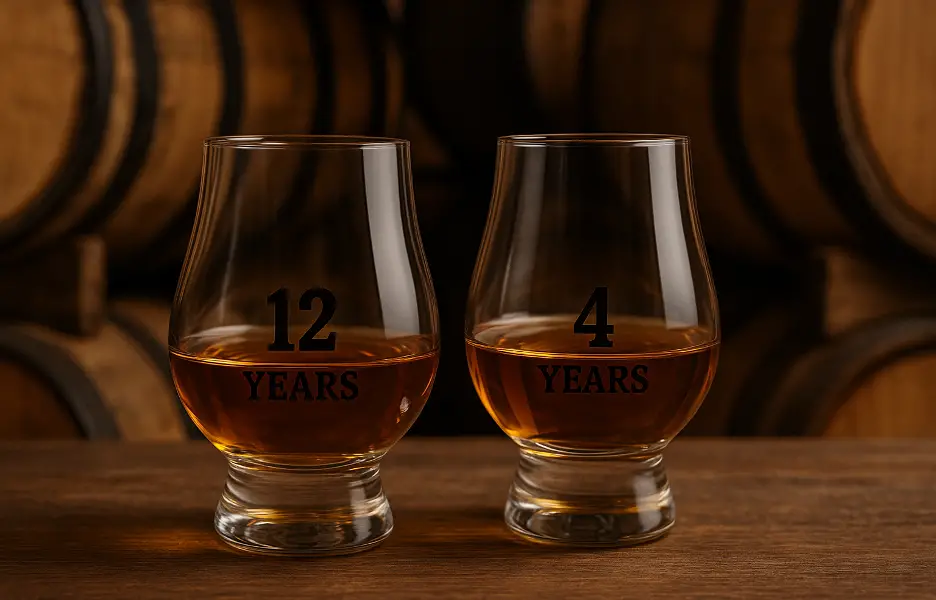
The Journey of Bourbon: Understanding the Aging Process
Bourbon is more than just America’s native spirit; it’s a patient collaboration between nature, craftsmanship, and time. The nuances of bourbon aging shape everything we love about this whiskey—the flavor, the color, the aroma. Whether you’re exploring your first bottle or seeking the hidden depths of a 12-year-old expression, understanding how bourbon matures can transform your appreciation of every sip.
Why Are Bourbon Barrels Always New and Charred?
By law, bourbon must be aged in new, charred oak barrels—a tradition that dates back to early American whiskey-making. Charring the barrels caramelizes the wood’s sugars, creating rich layers of vanilla, spice, and toasty flavors that define bourbon’s profile.
Unlike Scotch, which can use secondhand barrels, bourbon’s insistence on new oak ensures a bolder, sweeter, wood-forward spirit. The “charred” part matters, too: it acts like a natural filter and flavor booster, pulling impurities from the spirit and embedding deep smoky-sweet notes.
Top producers like Maker’s Mark have perfected their barrel treatments, carefully controlling the char level to create distinctive house styles. Maker’s Signature Red Top uses heavily charred barrels to deliver its famously soft vanilla and cinnamon profile. Meanwhile, brands like Four Roses may choose different char levels for their multiple mash bills to create unique expressions from the same warehouse.
Smaller craft distilleries across the U.S. have also leaned into barrel experimentation. Some use ultra-toasted staves in addition to standard char, others char the barrels to extreme levels for maximum impact, producing intense flavor profiles in just a few years. The barrel is more than a container—it’s a co-creator, shaping everything from aroma to mouthfeel.
What’s the Difference Between a 4-Year and a 12-Year Bourbon?
Age matters—but maybe not in the way you think. A 4-year bourbon, like Jim Beam White Label, tends to be brighter, grainier, and slightly more aggressive. It still carries that unmistakable vanilla-caramel goodness, but with more youthful edges. These young bourbons are often bottled at lower proofs and designed for mixing or easy sipping.
A 12-year bourbon, like Elijah Craig 12 or some rare expressions of Maker’s Mark Private Select, softens out those rough corners. Expect richer oak influence, deeper toffee and spice flavors, and a smoother, more contemplative sip. The wood has had time to infuse the spirit with tannins, leather, and complexity. However, older isn’t always better—too much time in the barrel, especially in Kentucky’s fluctuating climate, can over-oak a whiskey.
Between those bookends, there’s a sweet spot. Bourbons in the 6-to-10-year range often strike the perfect balance between the spirit’s youthful energy and the depth of aging. Brands like Knob Creek, Wild Turkey 101, and Buffalo Trace live in this zone—full of character, widely available, and adored by both new and seasoned drinkers.
Does Bourbon Age Differently in Kentucky Than in Other States?
Absolutely. Kentucky’s climate—with its hot summers and cold winters—creates ideal conditions for dynamic bourbon aging. The seasonal swings cause the spirit to expand and contract within the barrel, drawing out rich flavors faster than in cooler, more stable environments.
In contrast, bourbon aged in cooler states like Washington or Oregon, or in temperature-controlled warehouses, matures more slowly. The result is often a lighter, subtler profile, with fewer tannins and more emphasis on grain character. That’s not a bad thing—it just creates a different style of bourbon.
States like Texas and Colorado bring their own extremes. Brands like Garrison Brothers age in the Texas heat, accelerating maturation and yielding big, oak-driven flavors in just a few years. Meanwhile, Breckenridge Bourbon leverages high-altitude conditions to craft bold spirits with mountain-born character. Aging isn’t just about time; it’s about where that time happens.
How Water Composition Adds Another Layer
Kentucky’s reputation doesn’t rest solely on climate. The state’s limestone-filtered water is prized in bourbon-making because it’s rich in calcium and low in iron. This makes it ideal not just for fermentation but for developing a clean, clear spirit pre-aging. It’s often said you can taste the terroir of Kentucky in the water itself, which lays the foundation for aging to build upon.
Can Temperature Swings Really Change the Way Bourbon Tastes?
Yes—temperature swings are crucial to the aging process. During hot months, the bourbon soaks deep into the barrel’s wood. In the cold, it contracts, pulling the extracted flavors back into the liquid.
This cycle develops complexity, marrying sweet caramel, vanilla, smoky char, and spicy oak notes into a cohesive whole. Without these natural fluctuations, bourbon would take much longer to achieve the deep, balanced character drinkers crave.
The rate of this exchange also affects mouthfeel. Rapid aging tends to emphasize boldness and tannin, while slower aging highlights balance and softness. The best distilleries know how to harness this rhythm, adjusting warehouse placement, rotating barrels, and even choosing the perfect warehouse floor to control the aging pace.
Some warehouses, like those used by Heaven Hill and Wild Turkey, are built to maximize vertical variation. Top-floor barrels may age faster due to more heat, while lower-floor barrels mature more slowly, developing deeper subtleties. Master blenders often marry barrels from different floors to create balanced, layered flavor.
Why Does Bourbon Stop Aging Once It’s Bottled?
Once bourbon leaves the barrel and enters a bottle, its chemical evolution essentially halts. Unlike wine, which can change dramatically in the bottle, whiskey is stable.
This means the 8-year bourbon you buy today will taste the same years down the road—assuming you store it properly, away from extreme temperatures and sunlight. Bottling locks in the spirit’s character, making that moment of capture an enduring piece of craftsmanship.
Collectors love this trait. It allows for consistent quality and intentionality. You’re drinking what the distiller intended, frozen at its peak. But that also means a 10-year-old bourbon in the bottle for 30 years isn’t a 40-year-old whiskey—it’s still just 10.
How to Store Bottled Bourbon
To maintain flavor integrity, always store bourbon upright in a cool, dark place. Avoid storing bottles in direct sunlight or near heat sources, as fluctuating conditions can cause cork deterioration or alcohol evaporation. Some aficionados also use parafilm around the cork for long-term storage to ensure minimal oxidation.
Beyond Age: What Else Influences Bourbon Flavor?
While time in the barrel is vital, other elements within the aging environment shape bourbon’s taste just as profoundly. These include:
Entry Proof and Its Role
The alcohol level at which distillate enters the barrel—known as entry proof—affects how it interacts with the oak. Most distilleries choose an entry proof between 110 and 125. Higher proof spirits tend to extract more tannins and spicy wood character, while lower proof entries (like Maker’s Mark at 110) retain more sweetness and fruit tones.
Toasting vs. Charring
Some barrels are toasted before they’re charred, particularly for double-oaked expressions. Toasting gently warms the wood, unlocking vanilla and caramel precursors. Charring creates a carbon layer, promoting both flavor extraction and filtration. The combination allows more control over bourbon flavor design.
Warehouse Position and Airflow
Open-air rickhouses create varied aging conditions from floor to floor. In contrast, temperature-controlled warehouses offer consistency but can lack the dynamic profile that fluctuating temperatures generate. Some distilleries even experiment with airflow designs, window placement, or intentional exposure to seasonal weather.
The Art of Blending
Master distillers rarely bottle from a single barrel unless it’s a specialty release. Most bourbons are blends of many barrels—sometimes hundreds. Blending allows consistency across releases and the ability to correct imbalances. It also gives producers creative leeway to design flavor profiles that hit the mark every time.
Flavor Development Timeline: From Harsh to Harmonious
Let’s take a closer look at how bourbon evolves in the barrel year by year:
- Year 0–1: New make (white dog) enters the barrel clear and raw. Initial interaction begins with mild caramel and wood.
- Year 2–4: Spirit develops basic bourbon characteristics: oak, spice, vanilla. Heat and ethanol still dominate. Often bottled for economy brands.
- Year 5–7: Complexity builds. Richer notes emerge—brown sugar, baking spice, toasted nuts. A popular range for mid-tier bourbons.
- Year 8–10: Flavor integration peaks. Bold oak, dried fruit, cocoa, leather. Balance of strength and smoothness.
- Year 11–14: Mature, with tannins and wood driving flavor. Not for everyone—some find these over-oaked.
- 15+ Years: Reserved for connoisseurs. Deep complexity, but risk of bitterness and dominance by oak and char.
Not all bourbons follow this path equally. A 10-year-old bourbon from Colorado might taste vastly different than a 10-year-old from Kentucky because of elevation, humidity, and daily thermal range.
Bourbon Barrels in the Global Spirits Economy
After their first (and only) use for bourbon, barrels go on to have storied second lives. Their contribution to the spirits industry doesn’t end at a Kentucky rickhouse.
Second Lives: Scotch, Rum, and Tequila
Used bourbon barrels are shipped around the world, especially to Scotland, where they’re used for aging single malts and blends. Their previous use imparts a gentler influence, ideal for spirits requiring subtle wood impact. Caribbean rum producers prize bourbon barrels for similar reasons, adding soft spice and vanilla to otherwise bold molasses-based distillates.
Even tequila—particularly reposado and añejo—benefits from the mellowing and flavoring properties of ex-bourbon barrels. In fact, global demand for used barrels is a multi-million-dollar industry.
Barrel-Aged Beer and Wine
Craft breweries have jumped on the trend, aging imperial stouts, barleywines, and even sour ales in ex-bourbon casks. The result? Rich, boozy beers laced with vanilla, char, and oak. Wineries also use these barrels to introduce new flavor dimensions to port and zinfandel.
The Craft of the Cooperage
The journey of bourbon barrels begins long before aging. Cooperages like Independent Stave Company and Kelvin Cooperage craft barrels using air-seasoned staves, precision toasting, and fire charring. Barrel construction is a mix of tradition and innovation.
Each barrel contains around 30 staves, held together with steel hoops—no glue or nails. This all-wood architecture allows the barrel to breathe, a vital component of whiskey maturation. The wood is often seasoned outdoors for months or years before being shaped and fired, allowing harsh tannins to leach out before the spirit ever touches it.
Some distilleries even work directly with cooperages to customize barrels. These collaborations lead to proprietary chars, special oak treatments, and innovations like grooved or spiral-inside staves designed to maximize surface interaction.
The Collector’s Perspective: Barrel Influence on Limited Releases
In recent years, bourbon fans have gravitated toward limited releases and barrel-finished expressions. Pappy Van Winkle, Buffalo Trace Antique Collection, and Four Roses Small Batch Limited Edition are all coveted not just for their age or mash bill, but for the quality and selection of the barrels they matured in.
Single barrel selections allow retailers and private groups to choose their favorite barrels—often with tasting notes and custom labels. The concept turns each release into a unique experience, highlighting just how much influence one barrel can have.
Q&A
1. How does the char level on bourbon barrels affect flavor?
Deeper char levels caramelize the oak’s natural sugars, adding layers of sweetness, toast, and smoke to the spirit. The heavier the char, the more intense the notes of vanilla, spice, and roasted wood.
2. Why are bourbon barrels used only once?
By law, bourbon must be aged in new, charred oak barrels to ensure a fresh, intense flavor extraction. Once used, the barrel’s flavor-giving potential diminishes, making it better suited for aging other spirits like Scotch or rum.
3. Can bourbon age too long?
Yes—too much time in the barrel can result in an over-oaked whiskey, where wood tannins overwhelm the subtler flavors. These bourbons often taste bitter, dry, or overly tannic.
4. Does the size of the barrel affect aging?
Smaller barrels expose the spirit to more wood surface area, speeding up the aging process. While this can create bold flavors quickly, it also risks over-oaking and imbalanced results.
5. What kind of oak is used for bourbon barrels?
American white oak (Quercus alba) is the standard due to its strength, workability, and rich flavor profile. It imparts vanilla, caramel, and coconut notes that define classic bourbon character.
6. How important is warehouse placement in bourbon aging?
Very important—barrels aged on higher floors experience greater temperature swings, leading to faster aging and deeper flavor extraction. Lower floors offer cooler, slower maturation with subtler results.
7. Why does bourbon stop aging once it’s bottled?
Aging requires oxygen and wood interaction, both of which end when bourbon is sealed in glass. The flavor profile is effectively locked in, remaining stable for decades if stored properly.
8. What’s the “angel’s share” and why does it matter?
The angel’s share is the portion of bourbon lost to evaporation during aging. It concentrates the remaining spirit, often intensifying flavor and proof over time.
9. What are some signs of over-aged bourbon?
You might notice excessive bitterness, dryness, or astringency in the mouthfeel. These are signals that the oak has dominated the spirit, masking complexity.
10. What is “barrel proof” bourbon?
Barrel proof bourbon is bottled straight from the barrel without dilution, often at 110–130 proof. It delivers full-bodied, unfiltered flavor for drinkers who want the spirit in its purest form.
Final Pour
Bourbon’s journey from clear white dog to dark amber treasure is as complex and characterful as the spirit itself. Aging in charred new oak barrels isn’t just a requirement—it’s the heart of what makes bourbon, bourbon.
From climate and warehouse floor to char level and wood grain, every element shapes the final product. Appreciating bourbon aging is more than understanding years on a label. It’s about savoring the slow conversation between spirit and barrel, one summer and winter at a time.
Raise your glass to that patient transformation—and the centuries of American craftsmanship behind it.
Cheers.



